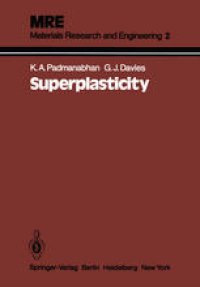
Ebook: Superplasticity: Mechanical and Structural Aspects, Environmental Effects, Fundamentals and Applications
- Tags: Characterization and Evaluation of Materials, Condensed Matter Physics
- Series: MRE Materials Research and Engineering
- Year: 1980
- Publisher: Springer-Verlag Berlin Heidelberg
- Edition: 1
- Language: English
- pdf
This is the second book in a new series - "Materials Research and Engineering" - devoted to the science and technology of materials. "Materials Research and Engineering" evolves from a previous series on "Reine und Allgemeine Metallkunde", which was edited by Werner KBster until his eightieth birthday in 1976. Although the present series is an outgrowth of the earlier one, it should not and cannot be regarded as a continuation. There had to be a shift of scope - and a change in presenta tion as well. Metallurgy is no longer an isolated art and science. Rather, it is linked by its scientific basis and technological implications to non-metallic and composite materials, as well as to processes for production, refining, shaping, surface treatment, and application. Thus, the new series, "Materials Research and Engineering", will present up-to-date information on scientific and technological pro gress, as well as on issues of general relevance within the engineering field and industrial society. Following the general position analysis of materials in the present world as given in volume 1, now volume 2 focuses on a special topic: It provides a thorough treatment of theoretical, experimental, and applied aspects of superplasticity.
This book examines the idea that under the right experimental conditions any material can be rendered superplastic and it raises the question whether such a near-universal phenomenon like superplasticity should also have the same physical basis.
The book tries to combine the perspectives of materials science, on the one hand, and that of design and mechanics, on the other, because the authors believe that only a holistic view of materials, design, mechanics and performance can lead to useful solutions of societal benefits, in addition to providing great intellectual challenges. After considering the experimental evidence for superplasticity in different classes of materials, the authors discuss the physics- and phenomenology- based models, along with their advantages and limitations. Then, the analyses for superplastic forming available in the framework of continuum mechanics, finite element analysis and numerical simulations are presented. Finally, the book highlights some successful industrial applications.
This book examines the idea that under the right experimental conditions any material can be rendered superplastic and it raises the question whether such a near-universal phenomenon like superplasticity should also have the same physical basis.
The book tries to combine the perspectives of materials science, on the one hand, and that of design and mechanics, on the other, because the authors believe that only a holistic view of materials, design, mechanics and performance can lead to useful solutions of societal benefits, in addition to providing great intellectual challenges. After considering the experimental evidence for superplasticity in different classes of materials, the authors discuss the physics- and phenomenology- based models, along with their advantages and limitations. Then, the analyses for superplastic forming available in the framework of continuum mechanics, finite element analysis and numerical simulations are presented. Finally, the book highlights some successful industrial applications.
Content:
Front Matter....Pages I-XIV
Historical Introduction....Pages 1-7
The Mechanics of Superplastic Deformation and the Assessment of Superplastic Behaviour....Pages 8-42
Structural Superplasticity — Experimental....Pages 43-132
Structural Superplasticity — Theoretical....Pages 133-200
Environmental Superplasticity....Pages 201-225
Applications of Superplasticity....Pages 226-268
Back Matter....Pages 269-314
This book examines the idea that under the right experimental conditions any material can be rendered superplastic and it raises the question whether such a near-universal phenomenon like superplasticity should also have the same physical basis.
The book tries to combine the perspectives of materials science, on the one hand, and that of design and mechanics, on the other, because the authors believe that only a holistic view of materials, design, mechanics and performance can lead to useful solutions of societal benefits, in addition to providing great intellectual challenges. After considering the experimental evidence for superplasticity in different classes of materials, the authors discuss the physics- and phenomenology- based models, along with their advantages and limitations. Then, the analyses for superplastic forming available in the framework of continuum mechanics, finite element analysis and numerical simulations are presented. Finally, the book highlights some successful industrial applications.
Content:
Front Matter....Pages I-XIV
Historical Introduction....Pages 1-7
The Mechanics of Superplastic Deformation and the Assessment of Superplastic Behaviour....Pages 8-42
Structural Superplasticity — Experimental....Pages 43-132
Structural Superplasticity — Theoretical....Pages 133-200
Environmental Superplasticity....Pages 201-225
Applications of Superplasticity....Pages 226-268
Back Matter....Pages 269-314
....